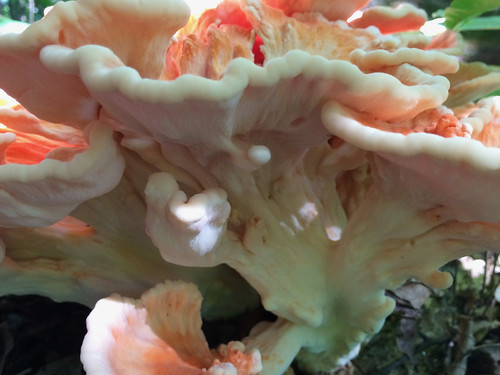Scientific Name(s): Laetiporus sulphureus
Abundance: uncommon
What: mushroom
How: cooked
Where: dead trees in the woods
When: summer
Nutritional Value: minerals, vitamins, carbohydrates
Dangers: Older, pale ones can cause stomach distress, as well as those growing on pines or eucalyptus trees
COLLECTING MUSHROOM REQUIRES 100% CERTAINTY. WWW.FORAGINGTEXAS.COM ACCEPTS NO RESPONSIBILITY FOR IDENTIFICATION ERRORS BY ANY READERS.
Growth Form: Laetiporus sulphureus typically grows in large, thick clusters on trees, logs, or stumps.
Cap Shape and Size: The individual caps are fan or shelf-shaped, measuring 2 to 12 inches across. They are bright orange to yellow in color. The orange color is often in bands.
Gills or Pores: This species does not have gills but features bright yellow pores underneath the cap.
Stipe Characteristics: Laetiporus sulphureus does not typically have a distinct stipe; the caps grow directly from the wood.
Odor: The mushroom has a mild, not distinctive odor.
Bruising: The flesh does not change color significantly upon bruising.
Spore Color: The spore print is white.
Substrate and Habitat: It is commonly found on dead/dying deciduous trees, especially oaks, and can also grow on conifers.
Other Characteristics: This mushroom is famous for its meaty texture and flavor reminiscent of chicken. It's important to note that some individuals may have allergic reactions to this species.
Clusters of chicken of the woods growing along a downed tree.

Chicken of the woods growing on dead tree roots.

Close-up of top of mushroom.

Side view of chicken of the woods.

Closer side view of mushroom.

Even closer side view after part was harvested.

Underside of can be white or yellow.

Chicken of the woods diced up and cooked in a little butter with garlic and Italian parsley.

Older, pale one like this may cause stomach upset.

Chicken of the Woods mushrooms are considered a great beginner's mushroom because there's nothing else out there that looks like this. The bright orange color is lacking in other similar-shaped shelf mushrooms. It's this color that makes it so easy to spot Chicken of the Woods in the gloomy, damp, hardwood forests it prefers. Look for them on dead or dying oak, pecans, and sweetgum trees during the warmer months. Note that even if they're going on a live tree they are killing it from the inside. You don't want to find this mushroom on a favorite tree as that tree won't be alive much longer. On the plus side, a tree producing Chicken of the Woods will continue to produce these mushrooms for years, until the tree has rotted away.
The top will have bands of "Cheeto" orange stripes while the bottom will be white or yellow in color. Chicken of the Woods don't have gills or false gills, releasing their spores via tiny tubes. The texture should be soft and flexible and moist like a raw chicken breast. As they mature they get firm and tough though the tough areas can be trimmed away. I like to dice up the mushroom into small cubes and sauté them with garlic in a touch of butter. These mushrooms can absorb a lot of butter or oil, leading to a heavy, oily flavor if too much oil is used. If you don't want to use the mushroom right away the best way to keep them is to pickle them using in a cup of vinegar + 1.5 tsp salt + 3 cups water then hot-can them like pickled okra. Additional spices can be added. Freezing these mushrooms can lead to an off flavor whereas pickling seems to hold the flavor the best.










